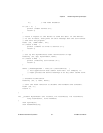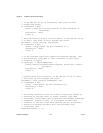
© National Instruments Corporation 8-1 NI-488.2 User Manual
8
NI-488.2 Programming
Techniques
This chapter describes techniques for using some NI-488.2 calls in your
application.
For more information about each function, refer to the NI-488.2 online
help. For instructions on accessing the online help, refer to the Using the
NI-488.2 Documentation section in About This Manual.
Termination of Data Transfers
GPIB data transfers are terminated either when the GPIB EOI line
is asserted with the last byte of a transfer or when a preconfigured
end-of-string (EOS) character is transmitted. By default, EOI is asserted
with the last byte of writes and the EOS modes are disabled.
You can use the
ibeot function to enable or disable the end of transmission
(EOT) mode. If EOT mode is enabled, the GPIB EOI line is asserted when
the last byte of a write is sent out on the GPIB. If it is disabled, the EOI line
is not asserted with the last byte of a write.
You can use the
ibeos function to enable, disable, or configure the EOS
modes. EOS mode configuration includes the following information:
• A 7-bit or 8-bit EOS byte.
• EOS comparison method—This indicates whether the EOS byte has
seven or eight significant bits. For a 7-bit EOS byte, the eighth bit of
the EOS byte is ignored.
• EOS write method—If this is enabled, the GPIB EOI line is
automatically asserted when the EOS byte is written to the GPIB. If the
buffer passed into an
ibwrt call contains five occurrences of the EOS
byte, the EOI line is asserted as each of the five EOS bytes are written
to the GPIB. If an
ibwrt buffer does not contain an occurrence of
the EOS byte, the EOI line is not asserted (unless the EOT mode is
enabled, in which case the EOI line is asserted with the last byte
of the write).


















